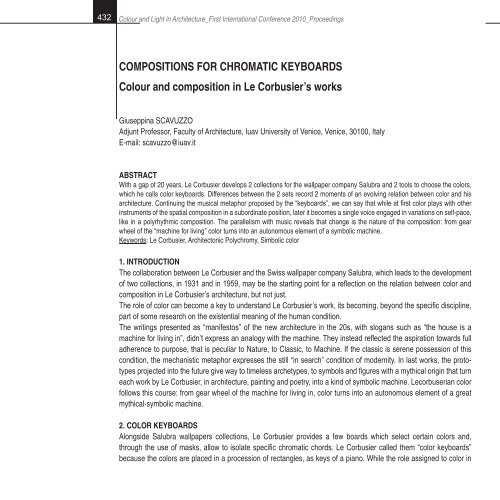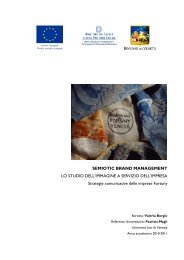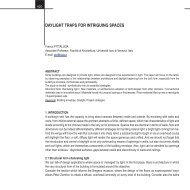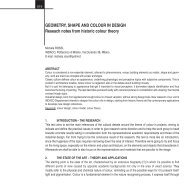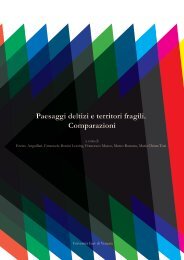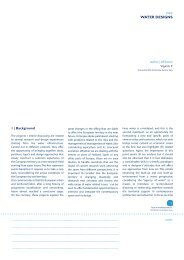Colour and composition in Le Corbusier's works
Colour and composition in Le Corbusier's works
Colour and composition in Le Corbusier's works
You also want an ePaper? Increase the reach of your titles
YUMPU automatically turns print PDFs into web optimized ePapers that Google loves.
432 <strong>Colour</strong> <strong>and</strong> Light <strong>in</strong> Architecture_First International Conference 2010_Proceed<strong>in</strong>gs<br />
COMPOSITIONS FOR CHROMATIC KEYBOARDS<br />
<strong>Colour</strong> <strong>and</strong> <strong>composition</strong> <strong>in</strong> <strong>Le</strong> Corbusier’s <strong>works</strong><br />
Giusepp<strong>in</strong>a SCAVUZZO<br />
Adjunt Professor, Faculty of Architecture, Iuav University of Venice, Venice, 30100, Italy<br />
E-mail: scavuzzo@iuav.it<br />
ABSTRACT<br />
With a gap of 20 years, <strong>Le</strong> Corbusier develops 2 collections for the wallpaper company Salubra <strong>and</strong> 2 tools to choose the colors,<br />
which he calls color keyboards. Differences between the 2 sets record 2 moments of an evolv<strong>in</strong>g relation between color <strong>and</strong> his<br />
architecture. Cont<strong>in</strong>u<strong>in</strong>g the musical metaphor proposed by the “keyboards”, we can say that while at first color plays with other<br />
<strong>in</strong>struments of the spatial <strong>composition</strong> <strong>in</strong> a subord<strong>in</strong>ate position, later it becomes a s<strong>in</strong>gle voice engaged <strong>in</strong> variations on self-pace,<br />
like <strong>in</strong> a polyrhythmic <strong>composition</strong>. The parallelism with music reveals that change is the nature of the <strong>composition</strong>: from gear<br />
wheel of the “mach<strong>in</strong>e for liv<strong>in</strong>g” color turns <strong>in</strong>to an autonomous element of a symbolic mach<strong>in</strong>e.<br />
Keywords: <strong>Le</strong> Corbusier, Architectonic Polychromy, Simbolic color<br />
1. INTRODUCTION<br />
The collaboration between <strong>Le</strong> Corbusier <strong>and</strong> the Swiss wallpaper company Salubra, which leads to the development<br />
of two collections, <strong>in</strong> 1931 <strong>and</strong> <strong>in</strong> 1959, may be the start<strong>in</strong>g po<strong>in</strong>t for a reflection on the relation between color <strong>and</strong><br />
<strong>composition</strong> <strong>in</strong> <strong>Le</strong> Corbusier’s architecture, but not just.<br />
The role of color can become a key to underst<strong>and</strong> <strong>Le</strong> Corbusier’s work, its becom<strong>in</strong>g, beyond the specific discipl<strong>in</strong>e,<br />
part of some research on the existential mean<strong>in</strong>g of the human condition.<br />
The writ<strong>in</strong>gs presented as “manifestos” of the new architecture <strong>in</strong> the 20s, with slogans such as “the house is a<br />
mach<strong>in</strong>e for liv<strong>in</strong>g <strong>in</strong>”, didn’t express an analogy with the mach<strong>in</strong>e. They <strong>in</strong>stead reflected the aspiration towards full<br />
adherence to purpose, that is peculiar to Nature, to Classic, to Mach<strong>in</strong>e. If the classic is serene possession of this<br />
condition, the mechanistic metaphor expresses the still “<strong>in</strong> search” condition of modernity. In last <strong>works</strong>, the prototypes<br />
projected <strong>in</strong>to the future give way to timeless archetypes, to symbols <strong>and</strong> figures with a mythical orig<strong>in</strong> that turn<br />
each work by <strong>Le</strong> Corbusier, <strong>in</strong> architecture, pa<strong>in</strong>t<strong>in</strong>g <strong>and</strong> poetry, <strong>in</strong>to a k<strong>in</strong>d of symbolic mach<strong>in</strong>e. <strong>Le</strong>corbuserian color<br />
follows this course: from gear wheel of the mach<strong>in</strong>e for liv<strong>in</strong>g <strong>in</strong>, color turns <strong>in</strong>to an autonomous element of a great<br />
mythical-symbolic mach<strong>in</strong>e.<br />
2. COLOR KEYBOARDS<br />
Alongside Salubra wallpapers collections, <strong>Le</strong> Corbusier provides a few boards which select certa<strong>in</strong> colors <strong>and</strong>,<br />
through the use of masks, allow to isolate specific chromatic chords. <strong>Le</strong> Corbusier called them “color keyboards”<br />
because the colors are placed <strong>in</strong> a procession of rectangles, as keys of a piano. While the role assigned to color <strong>in</strong>
Fig.1<br />
The 12 color keyboards of the<br />
first collection Salubra<br />
Fig.2<br />
The 14 basic colors<br />
433 <strong>Colour</strong> <strong>and</strong> Light <strong>in</strong> Architecture_First International Conference 2010_Proceed<strong>in</strong>gs<br />
Purist period is expla<strong>in</strong>ed <strong>in</strong> various texts, color keyboards provide, <strong>in</strong> a cryptic form, the evidence of the gradual shift<br />
<strong>in</strong> the way of conceiv<strong>in</strong>g the color.<br />
In the Après le Cubism, Jeanneret wrote that the idea of form precedes that of color, it is prom<strong>in</strong>ent, the color is only<br />
one of its accessories. This position, is modified <strong>in</strong> Polycromie architecturale, the text written <strong>in</strong> the 30s, where <strong>Le</strong><br />
Corbusier quotes Léger: “Man needs color to live, it is just as necessary an element as water or fire”; here he expla<strong>in</strong>ed<br />
how color can change space perception of architecture <strong>and</strong> tried to expla<strong>in</strong> what could lead one of the ma<strong>in</strong><br />
responsibles of the <strong>in</strong>vention of modern space to get concerned with an object that is peculiar to <strong>in</strong>terior decoration,<br />
very distant from the new concept of the modern house.<br />
First, he replaced the expression “wallpaper” with “oil pa<strong>in</strong>t <strong>in</strong> rolls”, with reference to the production technology of<br />
Salubra wallpaper, created by means of spread<strong>in</strong>g oil pa<strong>in</strong>t<strong>in</strong>g on a base of thick paper. Then, he expla<strong>in</strong>ed his <strong>in</strong>terest<br />
for Salubra as the <strong>in</strong>terest of a builder, motivated by two arguments: the rolls imply, compared to the application of<br />
colors <strong>in</strong> a build<strong>in</strong>g yard, the advantage of be<strong>in</strong>g available anywhere, even <strong>in</strong> the absence of exact color pigments <strong>and</strong><br />
<strong>in</strong>volve complex measur<strong>in</strong>g operations. So the oil pa<strong>in</strong>t <strong>in</strong> rolls meets one of the ma<strong>in</strong> missions of new architecture: to<br />
determ<strong>in</strong>e st<strong>and</strong>ards which set certa<strong>in</strong> qualities <strong>and</strong> make them easily available. The second advantage is the durabil-
Fig.3<br />
The <strong>composition</strong> of the keys of<br />
keyboard n.11<br />
Fig. 4<br />
A keyboard <strong>and</strong> two masks<br />
Fig. 5<br />
The masks on the keyboard<br />
isolate chromatic chords<br />
434 <strong>Colour</strong> <strong>and</strong> Light <strong>in</strong> Architecture_First International Conference 2010_Proceed<strong>in</strong>gs<br />
ity: Salubra paper is washable, elastic, heat resistant.<br />
The first collection <strong>in</strong>cludes 43 colors. The keyboards are<br />
12, each of them divided <strong>in</strong>to five b<strong>and</strong>s, three <strong>in</strong> one color,<br />
the “ background tones”, two composed of 14 key colors,<br />
the notes. Each keyboard has a title evocative of a chromatic<br />
atmosphere: Space, Sky, Velvet I <strong>and</strong> II, Masonry I<br />
<strong>and</strong> II, S<strong>and</strong>s I <strong>and</strong> II, L<strong>and</strong>scape, Checkered I, II <strong>and</strong> III<br />
(Fig. 1).<br />
The codes of <strong>in</strong>dividual shades <strong>in</strong>dicate that the 43 colors<br />
derive from 14 basic colors, varied, by add<strong>in</strong>g white,<br />
<strong>in</strong> colors that get clearer <strong>and</strong> clearer (Fig. 2). The basic<br />
colors, which <strong>Le</strong> Corbusier correspond partially to those<br />
of the “ Great range”; def<strong>in</strong>ed at the time of purism for the<br />
“volume builder” colors: yellow ocher, sienna natural, sienna<br />
burned, ultramar<strong>in</strong>e blue, white, black; others colors<br />
belong to the purist “Dynamic range”, composed by colors<br />
that create a feel<strong>in</strong>g of movement of layers: carm<strong>in</strong>e<br />
<strong>and</strong> vermilion. no color comes from the purist “Transitive<br />
range”, composed by colors, like emerald green, that<br />
have no build<strong>in</strong>g properties.<br />
The arrangement of the “keys” follows criteria that we can<br />
only guess by observ<strong>in</strong>g, as <strong>Le</strong> Corbusier did not give any<br />
explanation. In each sheet the two rows of keys have the<br />
same sequence repeated. But Checkered II <strong>and</strong> III are exceptions,<br />
present<strong>in</strong>g different b<strong>and</strong>s. In Checkered II we<br />
can however identify a pr<strong>in</strong>ciple: divid<strong>in</strong>g the upper b<strong>and</strong> <strong>in</strong><br />
two sets of 7 colors, these series are repeated <strong>in</strong> reverse<br />
<strong>in</strong> the second b<strong>and</strong> (Fig. 3). Two screens supplied with<br />
the color plates allow to isolate either two shades or three<br />
shades aga<strong>in</strong>st two background tones, or two pairs or two<br />
trios of shades aga<strong>in</strong>st the background tone of the central<br />
b<strong>and</strong> (Figs 4-5).<br />
The second collection presents 20 colors <strong>and</strong> one keyboard<br />
only, composed by two b<strong>and</strong>s, each with 10 colors, without<br />
any background tones. The screens supplied have simple<br />
rectangular holes that allow to isolate a couple of colors on<br />
the two b<strong>and</strong>s or 2 pairs of colors from each b<strong>and</strong> (Fig. 6).
Fig. 6<br />
The keyboard of the second<br />
Salubra collection <strong>and</strong> the two<br />
masks<br />
Fig. 7<br />
The “Iconostasis” <strong>and</strong> the “Icon”<br />
<strong>in</strong> the Poème de l’Angle Droit<br />
435 <strong>Colour</strong> <strong>and</strong> Light <strong>in</strong> Architecture_First International Conference 2010_Proceed<strong>in</strong>gs<br />
3. SAVE FROM THE ARBITRARINESS<br />
As for the other most famous <strong>in</strong>strument designed by <strong>Le</strong> Corbusier, the Modulor with its series of harmonious proportions,<br />
the aim of the keyboards is to save the compositive choices from arbitrar<strong>in</strong>ess. The first step is to limit the<br />
range of possible choices. <strong>Le</strong> Corbusier wrote ever s<strong>in</strong>ce 1925 about the problematic position of the pa<strong>in</strong>ter <strong>in</strong> front<br />
of excessive choice of color, cit<strong>in</strong>g the piano keyboard as an <strong>in</strong>strument model that circumscribes <strong>and</strong> selects: “What<br />
is a piano? A choice of sounds necessary <strong>and</strong> sufficient. poor pa<strong>in</strong>ters ...! Chemists dream only to multiply the color<br />
tones ... Can you imag<strong>in</strong>e a piano with 73,000 different notes? ... Every visual artist has to devote more of their lives<br />
to create a piano”, Jeanneret [2], .<br />
Once the choice gets limited to certa<strong>in</strong> ranges, there comes the need to establish criteria to make, among the possible<br />
choices, the more harmonious ones. Compared to the choice of the right proportion, resolved by the Modulor,<br />
to constra<strong>in</strong> <strong>and</strong> save from the arbitrar<strong>in</strong>ess the choice of the best color comb<strong>in</strong>ation seems to be more difficult; <strong>Le</strong><br />
Corbusier admitted this difficulty, start<strong>in</strong>g the essay on architectural polychromy with the say<strong>in</strong>g: “Des goûts et des<br />
couleurs” which refers to the <strong>in</strong>evitable subjectivity that governs some aesthetic choices, <strong>and</strong> the chromatic ones per<br />
antonomasia.<br />
The criterion that justifies the restrictions is the architectonic one: the correct choice would be caused by apply<strong>in</strong>g<br />
pr<strong>in</strong>ciples which are not valid <strong>in</strong> the <strong>in</strong>f<strong>in</strong>ite range of colors, but specifically <strong>in</strong> the area of color choices <strong>in</strong> architecture.<br />
If the Modulor has two strong roots of legitimacy, one based on the history of civilization, <strong>in</strong> the tradition of the golden<br />
section, <strong>and</strong> the other on Nature, referr<strong>in</strong>g to measures of the human body, the references of the keyboards are less<br />
precise. For the first collection, historical authority <strong>and</strong> reference to nature are merged by us<strong>in</strong>g of colors of the purist<br />
“Great range”, used <strong>in</strong> the ancient frescoes <strong>and</strong> derived from natural pigments. The second collection shows a<br />
chromatic sensitivity that is so different that Salubra executives asked some changes to make the two series not too<br />
discordant the one from the other. The colors are mostly darker <strong>and</strong> there is a greater emphasis on red <strong>and</strong> blue.<br />
To expla<strong>in</strong> these changes, it is useful to trace the parallel evolv<strong>in</strong>g of the relation between color <strong>and</strong> architecture.<br />
In <strong>Le</strong> Corbusier architectures of the 20s, as <strong>in</strong> his purist pa<strong>in</strong>t<strong>in</strong>gs, the color is part of a <strong>composition</strong> <strong>in</strong> which the<br />
tones mimic the materials, transpos<strong>in</strong>g them <strong>in</strong> the abstract, by us<strong>in</strong>g the natural pigments of earth <strong>and</strong> vary<strong>in</strong>g the
436 <strong>Colour</strong> <strong>and</strong> Light <strong>in</strong> Architecture_First International Conference 2010_Proceed<strong>in</strong>gs<br />
<strong>in</strong>tensity by add<strong>in</strong>g white. The color so obta<strong>in</strong>ed collaborates to the construction of space: it can put space <strong>in</strong> tension,<br />
dismantle it or block it.<br />
In La Roche-Jeanneret house it is possible to observe three different k<strong>in</strong>ds of space, constructed with the aid of color.<br />
The first is the traditional space of the “room”, where color, spread evenly on the four walls, gives its character to the<br />
p<strong>in</strong>k d<strong>in</strong><strong>in</strong>g room. The second <strong>in</strong>terior is the double-height hall: here the space is broken by the <strong>in</strong>troduction of color<br />
on one s<strong>in</strong>gle face of white volumes, like <strong>in</strong> a house of cards with an orig<strong>in</strong> <strong>in</strong> Neo-plasticism. In the gallery, the typical<br />
space of the new architecture makes its appearance, not broken or blocked, but made “elastic” by color, which puts <strong>in</strong><br />
tension the space together with the pr<strong>in</strong>ciples of the new architecture (free plan, architecturale promenade)<br />
4. COLOR INSUBORDINATES<br />
<strong>Le</strong> Corbusier rarely applied the Salubra wallpapers to his architecture, but uses them as material for his collages,<br />
a preparatory exercise for tapestries, polychrome wood sculptures <strong>and</strong> lithographs. The relation between color <strong>and</strong><br />
“brut” raw materials, as it will emerge <strong>in</strong> the architecture, is prepared by the experiments carried out on the wooden<br />
sculptures: here color talks together with a material show<strong>in</strong>g all his ve<strong>in</strong>s, so it should not mime the material, as <strong>in</strong> the<br />
purist <strong>composition</strong>s, <strong>and</strong> can be free from natural pigments, us<strong>in</strong>g bright tones, near the primary ones.<br />
In the collages <strong>and</strong> <strong>in</strong> the lithographs, the subord<strong>in</strong>ation of the colored surface to the l<strong>in</strong>e is subverted, <strong>in</strong> a gradual<br />
process which is fully carried out <strong>in</strong> the lithographs of the Poème de l’Angle Droit. The expressive <strong>in</strong>dependence of<br />
color, is detectable also <strong>in</strong> the title page <strong>and</strong> <strong>in</strong> the “Iconostasis”. The title page is divided <strong>in</strong>to a daytime blue sky, with<br />
a red sun, <strong>and</strong> a night red sky, with a white crescent moon. Blue <strong>and</strong> red were used <strong>in</strong> the text Polychromie architecturale<br />
to expla<strong>in</strong> the concept of “architectural colors”, through examples that demonstrate their own abilities to change<br />
the perception of space. In the Poem, blue <strong>and</strong> red take an <strong>in</strong>dependent value: they appear <strong>in</strong>tertw<strong>in</strong>ed, as <strong>in</strong> the two<br />
sets of Modulor. The Iconostasis is the scheme which graphically represents the structure of the poem, divided <strong>in</strong>to<br />
seven parts, each of them with a title <strong>and</strong> a correspond<strong>in</strong>g color. The section entitled Caractére, is dom<strong>in</strong>ated by the<br />
image of the Icon, a female figure with h<strong>and</strong>s clasped <strong>in</strong> prayer which symbolizes the atta<strong>in</strong>ment of a higher state of<br />
grace; it is a white figure that seems to grow out of her clasped h<strong>and</strong>s, colored <strong>in</strong> blue <strong>and</strong> red (Fig. 7). In the essay<br />
on architectural polychromy, white is described as a background color that enhances the character of the color affixed<br />
on it, here white has an <strong>in</strong>dependent mean<strong>in</strong>g, becom<strong>in</strong>g the “Caractére” par excellence.<br />
5. POLYCROMY AND POLYRHYTHM<br />
Cont<strong>in</strong>u<strong>in</strong>g with the musical metaphor, suggested by the keyboards, we could say that dur<strong>in</strong>g the purist period the<br />
color “plays” with the other <strong>in</strong>struments of spatial <strong>composition</strong> <strong>in</strong> a subord<strong>in</strong>ate position, then becomes a “s<strong>in</strong>gle voice”<br />
engaged <strong>in</strong> variations on the theme, with an <strong>in</strong>dependent rhythm, as is <strong>in</strong> a polyrhythmic <strong>composition</strong>. The application of<br />
a method of musical counterpo<strong>in</strong>t, with <strong>in</strong>dependent rhythms for various components, is present <strong>and</strong> declared by <strong>Le</strong> Corbusier<br />
for various <strong>works</strong>, such as the Duval factory <strong>in</strong> St. Die. Here the structure, the brise-soleil <strong>and</strong> the partitions of the<br />
w<strong>in</strong>dows follow three different cadences; <strong>in</strong> the Unitè, an <strong>in</strong>dependent chromatic rhythm, non-hierarchically subord<strong>in</strong>ate
Fig. 8<br />
<strong>Le</strong> Corbusier’s sketch n.361,<br />
Carnets vol.3, 1954-1957.<br />
437 <strong>Colour</strong> <strong>and</strong> Light <strong>in</strong> Architecture_First International Conference 2010_Proceed<strong>in</strong>gs<br />
is superimposed to the rhythm<br />
given by an alternat<strong>in</strong>g succession<br />
of plans <strong>and</strong> corridors.<br />
It is someth<strong>in</strong>g similar to the<br />
variation on the theme <strong>and</strong> the<br />
polyrhythm characteristic of jazz<br />
music, that <strong>Le</strong> Corbusier had<br />
admired dur<strong>in</strong>g the early trips<br />
to America. A traditional music<br />
characterized by the polyrhythm<br />
is that of northern India, where<br />
the polyrhythm is l<strong>in</strong>ked to a circular<br />
conception of time, so that<br />
on a given basic rhythm, one<br />
may play potentially <strong>in</strong>def<strong>in</strong>itely,<br />
through variations <strong>and</strong> repetitions.<br />
This cyclical conception<br />
resonates <strong>in</strong> the writ<strong>in</strong>gs of <strong>Le</strong><br />
Corbusier dur<strong>in</strong>g the stays <strong>in</strong> India.<br />
It is also the mythical view<br />
that he transposes <strong>in</strong> the system<br />
of symbols of Ch<strong>and</strong>igarh’s<br />
projects or <strong>in</strong> other late <strong>works</strong>.<br />
The music-color parallel <strong>in</strong>dicates<br />
that what changes is not<br />
only the role of color, but the<br />
nature of the <strong>composition</strong> itself,<br />
once it has become a system of<br />
signs referr<strong>in</strong>g to a system of<br />
mean<strong>in</strong>gs, saved from arbitrar<strong>in</strong>ess<br />
to a level higher even than<br />
the laws of history <strong>and</strong> nature, <strong>in</strong><br />
a transcendent dimension.
438 <strong>Colour</strong> <strong>and</strong> Light <strong>in</strong> Architecture_First International Conference 2010_Proceed<strong>in</strong>gs<br />
6. COLORS AS SIGNS<br />
To express this system of mean<strong>in</strong>gs, color cannot be calibrated <strong>in</strong> a complex exercise <strong>in</strong> scales <strong>and</strong> chords as <strong>in</strong> the<br />
first Salubra collection <strong>in</strong> order to put <strong>in</strong> tension the space, to block a wall or make it visually distant, but it s<strong>in</strong>gs with<br />
the power of full color aga<strong>in</strong>st full color, as it happens <strong>in</strong> the second collection.<br />
The color range is reduced to a few oppos<strong>in</strong>g pairs. The colors are close to the prismatic ones: <strong>in</strong> an architecture<br />
with a metaphysical reference the elements of <strong>composition</strong>, <strong>in</strong>clud<strong>in</strong>g color, do not need a reference to the authority<br />
of canons, <strong>and</strong> even the authority of natural m<strong>in</strong>eral pigments, the colors are the immaterial essence of the refracted<br />
light, as <strong>in</strong> the dawn that <strong>Le</strong> Corbusier sketches <strong>in</strong> his carnet fly<strong>in</strong>g from Ch<strong>and</strong>igarh, show<strong>in</strong>g the colors of the solar<br />
spectrum (Fig. 8).. Like the Modulor, keyboards are a tool to f<strong>in</strong>d the way. Once found, one can go sure to the real<br />
dest<strong>in</strong>ation, that is a poetry that can touch the soul of man, mak<strong>in</strong>g him aware of be<strong>in</strong>g part of a greater mystery.<br />
REFERENCES<br />
1. Jeanneret C.-E.e Ozenfant A. , Après le cubism, Editions des Commentaire, paris,1918.<br />
2. Jeanneret C.-E.e Ozenfant A., La Pe<strong>in</strong>ture moderne, Cres, Paris,1925.<br />
3. <strong>Le</strong> Corbusier, Poème de l’Angle Droit, Tériade, parigi, 1955.<br />
4. <strong>Le</strong> Corbusier, Carnets, vol. 3, Herscher/Dessa<strong>in</strong> et Tolra, parigi, 1981.<br />
5. Rüegg A., <strong>Le</strong> Corbusier’s Polychromie architecturale <strong>and</strong> his color keyboards from 1931 <strong>and</strong> 1959, Birkhauser, Basel, 1997.


